Mastering onions in your aquaponics system is crucial for enhancing the freshness and flavor of your salads. Watching these culinary gems grow from seeds to harvest is a truly rewarding experience. It is essential to understand the specific needs of onions in an aquaponic environment, such as proper spacing and their symbiotic relationship with fish waste, to ensure a successful yield. By delving into the advantages and varieties of onions suitable for aquaponics, you can unlock a world of possibilities to elevate your culinary dishes.
When cultivating onions in your aquaponics system, it is important to consider factors like water quality, pH levels, and nutrient availability to promote healthy growth. Adequate spacing between onion plants allows for optimal root development and prevents overcrowding. The symbiotic relationship between onions and fish waste in aquaponics systems is beneficial, as the plants absorb nutrients from the waste, creating a sustainable cycle.
One popular variety of onion recommended for aquaponics is the Red Baron onion, known for its vibrant color and mild flavor. This variety thrives in aquaponic setups and adds a lovely touch to salads and other dishes. By exploring different onion types and experimenting with their growth in your system, you can customize your harvest to suit your culinary preferences.
In conclusion, mastering the cultivation of onions in your aquaponics system not only adds freshness and flavor to your salads but also allows you to engage in a sustainable and rewarding gardening practice. By understanding the specific requirements of onions, exploring different varieties, and optimizing growth conditions, you can elevate your culinary creations and enjoy the fruits of your labor.
Key Takeaways
When growing onions in your aquaponics system, it’s important to choose suitable types like Bermuda or chives. These varieties thrive in aquaponic environments and are well-suited for this type of cultivation. Maintaining the water temperature between 65-75°F and the pH levels at 6.0-6.5 is crucial for the optimal growth of onions. This ensures that they receive the right conditions to develop and flourish in your system.
Proper spacing between onions is also essential in aquaponic beds. Aim for a distance of 4-6 inches between each onion to allow them room to grow without overcrowding. This spacing allows for adequate access to nutrients and prevents competition among the plants for resources.
Utilizing fish waste nutrients is a key factor in promoting healthy onion development in your aquaponics system. The nutrients from the fish waste serve as natural fertilizers for the onions, supplying them with essential elements for growth. This symbiotic relationship between the fish and plants is what makes aquaponics such a sustainable and efficient method of cultivation.
When it comes time to harvest your onions, wait until the tops wither before harvesting them. Once harvested, you can cure the onions for storage to prolong their shelf life. Be sure to address any common issues that may arise during the growing process, such as pests or diseases, to ensure a successful harvest.
By following these guidelines and best practices, you can master the art of growing onions in your aquaponics system and enjoy a bountiful harvest of fresh, flavorful onions for your culinary creations.
Benefits of Growing Onions Aquaponically
Growing onions aquaponically offers many benefits that can improve your farming practices and the quality of your produce. Onions thrive in a hydroponic environment where they’ve access to ample water, nutrients, and oxygen. To ensure optimal growth, it’s important to maintain water temperatures between 65-75°F, pH levels around 6.0-6.5, and nutrient concentrations that benefit both the fish and the plants.
Adequate spacing is crucial in aquaponic beds to allow onions to grow fully without being overcrowded, typically requiring about 4-6 inches of space between plants. In aquaponics, the fish waste provides essential nutrients for the onions, creating a symbiotic relationship that supports plant growth.
When it comes time to harvest onions in an aquaponics system, gently uproot them once the tops have withered and dried. This allows for proper curing before storing them. Following these guidelines will help you achieve a plentiful harvest of nutrient-rich and disease-resistant onions from your aquaponics setup.
Types of Onions for Aquaponics
When growing onions in aquaponics, it’s essential to choose onion varieties that thrive in this unique environment. There are several excellent options to consider, each offering its own distinct qualities. Whether you prefer a mild taste, vibrant colors, or unique flavors, there’s an onion variety that will suit your preferences.
Here are some top choices for onions in aquaponics:
- Classic Bermuda Onions: These onions have a mild flavor and are versatile, making them perfect for various dishes like salads, soups, and stir-fries.
- Chives: Easy to grow and add a unique flavor to dishes, chives are great for garnishing, adding to salads, or using in spreads.
- Red Onions: Known for their colorful and flavorful nature, red onions add vibrancy to salads and dishes when used raw, such as in salads or sandwiches.
- Leeks: With their mild and sweet flavor, leeks thrive in aquaponics systems and are ideal for soups, stews, and casseroles.
When planting onions in aquaponics, ensure they receive adequate light for optimal growth. It’s also important to be aware of common onion problems in aquaponics and be prepared to address any issues that may arise to ensure a successful harvest. Each of these onion varieties offers unique characteristics that can enhance your aquaponics setup and provide a bountiful harvest.
Temperature Requirements for Onions
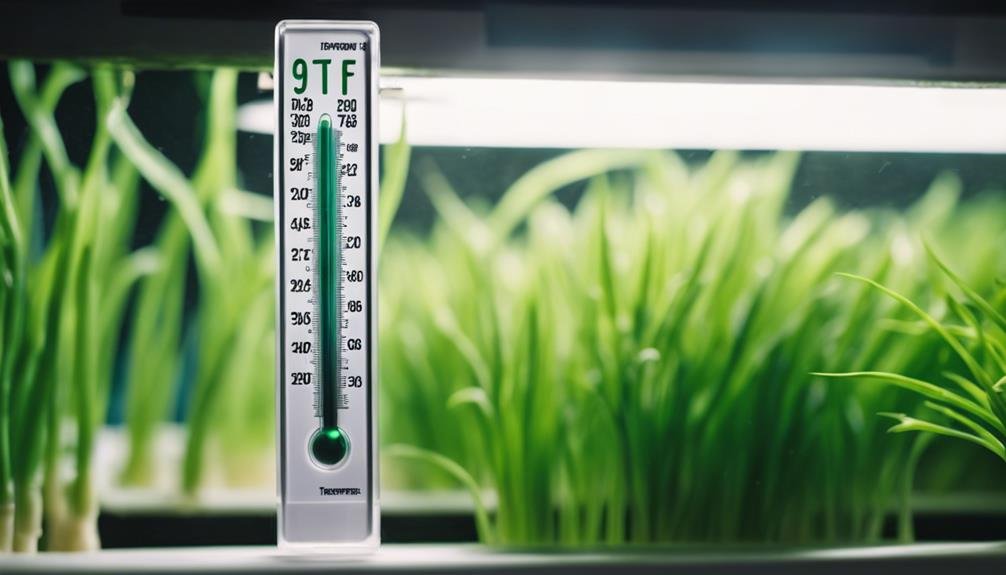
Onions grow best in aquaponics systems when the water temperature stays within the range of 55°F to 75°F. It’s crucial to maintain these temperatures for optimal onion growth in your aquaponics setup.
Here are some important points to consider:
- Ideal Conditions: Onions thrive in water temperatures between 55°F to 75°F.
- Temperature Balance: Ensure that the air temperature matches or is slightly higher than the water temperature to promote healthy onion development.
- Avoid Extremes: While onions can withstand air temperatures up to 90°F, temperatures below 40°F may cause premature bolting in onions.
Maintaining the right temperature range is key to the successful cultivation of onions in aquaponics. By monitoring and regulating the water and air temperatures within the recommended range, you can support the growth and health of your onion plants effectively.
Remember to provide a stable and suitable environment for your onions to thrive and avoid any temperature extremes that could hinder their development.
Maintaining Ideal Water Ph Levels
Maintaining ideal water pH levels between 6 to 7 is crucial for the optimal growth and flavor of your aquaponically grown onions. Keeping the water pH neutral is key to enhancing the taste of your onions in aquaponics.
Fluctuations in pH levels can affect how well your onions absorb necessary nutrients, impacting their overall health. Regularly checking and adjusting the water pH is vital for the success of your onion cultivation in aquaponics.
Imbalanced pH levels can lead to stunted growth, nutrient deficiencies, and poor onion quality in your aquaponic system. By ensuring the water pH stays within the recommended range, you can provide your onions with the proper nutrition they require to thrive.
Nutrient Demands of Onions
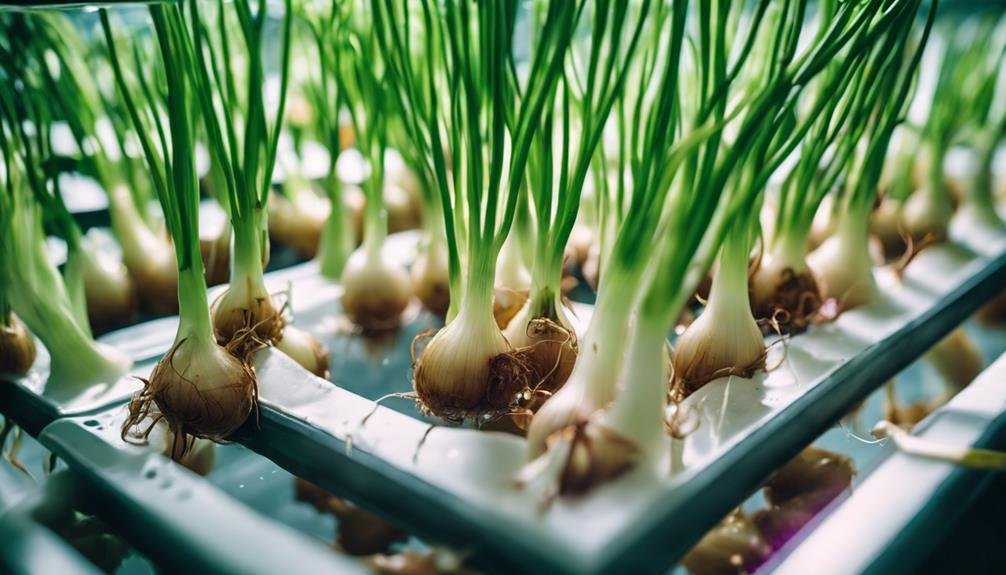
To ensure your aquaponically grown onions thrive and develop properly, it’s crucial to monitor zinc levels. Onions have specific nutrient needs that must be met for optimal growth and health. Here are some key points to consider:
- Having enough nitrogen is crucial for the proper development of leaf color in onions.
- Adjust nitrogen levels accordingly as onion leaves transition from a deep green to a medium green hue.
- It’s important to carefully monitor potassium levels to support the overall growth of onions.
Growing Onions in Gravel Beds
Growing onions in gravel beds offers a great environment for robust plant growth due to excellent drainage and root aeration. The gravel beds’ stability supports the onion roots, making it simple for them to absorb crucial nutrients.
The flood and drain system in gravel beds helps maintain optimal moisture levels, promoting healthy onion development. This setup prevents waterlogging, ensuring the roots stay in good condition. Gravel beds are versatile and contribute to a strong root system in onions, crucial for bulb formation and overall plant health.
Monitoring Nutrient Levels
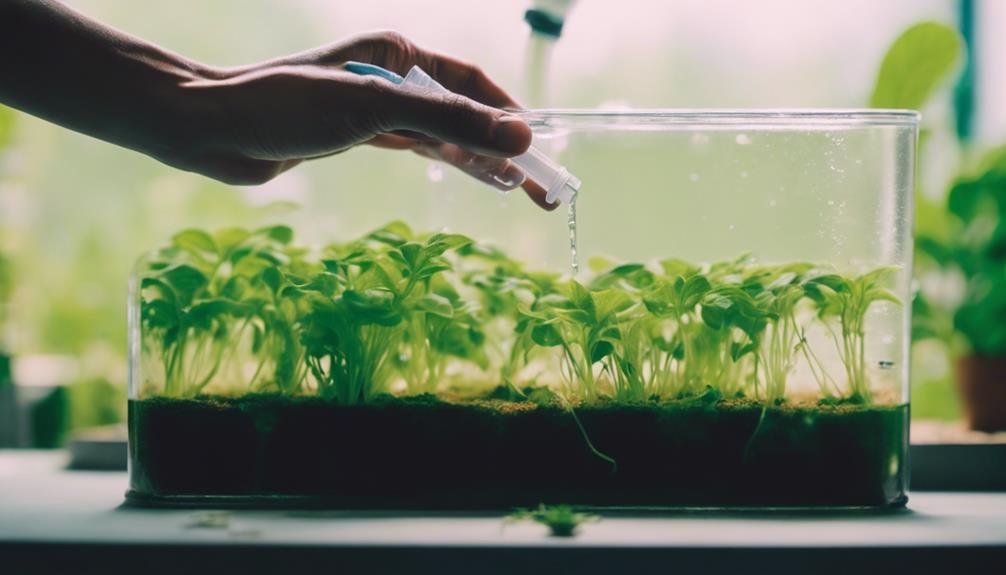
Testing water regularly for nitrogen levels is crucial to maintain optimal leaf color and growth in your aquaponic onions. Monitoring nutrient levels is essential for the overall health and progress of your crop. Here are some key points to remember:
- Regularly test water for nitrogen levels to ensure the best conditions for growth.
- Keep a close watch on zinc levels as they can influence the development of onions.
- Adjust nitrogen levels gradually as the color of onion leaves changes to achieve the most favorable results.
Selecting Fish Species for Onions
When selecting fish species to grow alongside onions in your aquaponics system, it’s essential to choose ones that thrive in cooler temperatures. Fish such as Tilapia, goldfish, Koi, and perch are great options as they prefer these conditions, which align well with the temperature needs of onions. While Arctic char can be considered, it might face challenges adjusting to the temperature variations within the aquaponics setup.
It’s crucial to pick fish species that can coexist harmoniously with onions in the same environment to maximize productivity. By creating a balanced ecosystem where fish and onions complement each other, you can promote the successful growth of both. Additionally, onions can be densely planted alongside fish in the aquaponics system, making efficient use of space and resources.
Importance of Air Temperatures
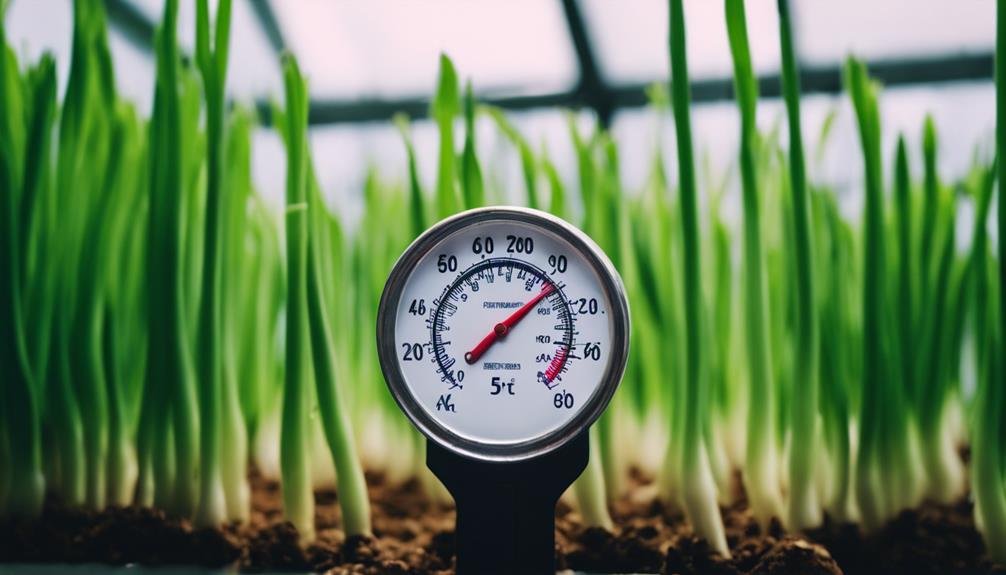
Maintaining the right air temperatures is crucial for the optimal growth and health of onions in your aquaponics setup. To grasp the significance of air temperatures in cultivating onions, consider the following key points:
Onions thrive when the air temperatures are similar to or slightly higher than the water temperature. They can tolerate temperatures up to 90°F, but if it drops below 40°F, they might start to bolt. It’s essential to keep the air temperatures at the right levels to avoid stressing the onions and to promote their best growth.
Ensuring that the air temperatures are suitable for your onions can make a significant difference in their development. By providing the ideal environment, you can help your onions flourish and produce a bountiful harvest. Remember to monitor the temperatures closely and make adjustments as needed to support the health and vitality of your onion plants.
Harvesting Onions in Aquaponics
When it’s time to harvest onions in your aquaponics setup, wait for the tops to dry out completely. This indicates that the onions are ready for harvesting. Gently lift the onions from the growing media, being careful not to cause any damage to the bulbs. This step is crucial to ensure a successful harvest.
Once you have harvested the onions, it’s important to cure them. Place the onions in a warm, dry area with good air circulation for 2-3 weeks. This curing process enhances the flavor of the onions and helps extend their storage life. After curing, store the onions in a cool, dry place with proper ventilation. This will help maintain the quality of the onions for several months.
Before storing the onions, make sure to inspect them for any signs of damage or disease. Removing any spoiled onions will prevent the spread of issues to other onions in storage. By following these steps, you can enjoy fresh, flavorful onions from your aquaponics system for an extended period.
For a successful harvest and storage of onions in your aquaponics system, remember the following steps:
- Wait for the tops to dry out completely.
- Gently lift the onions from the growing media.
- Cure the onions in a warm, dry place for 2-3 weeks.
- Store the cured onions in a cool, dry place with proper ventilation.
- Inspect the onions for any damage before storing them to prevent spoilage.
Onion Pest and Disease Management
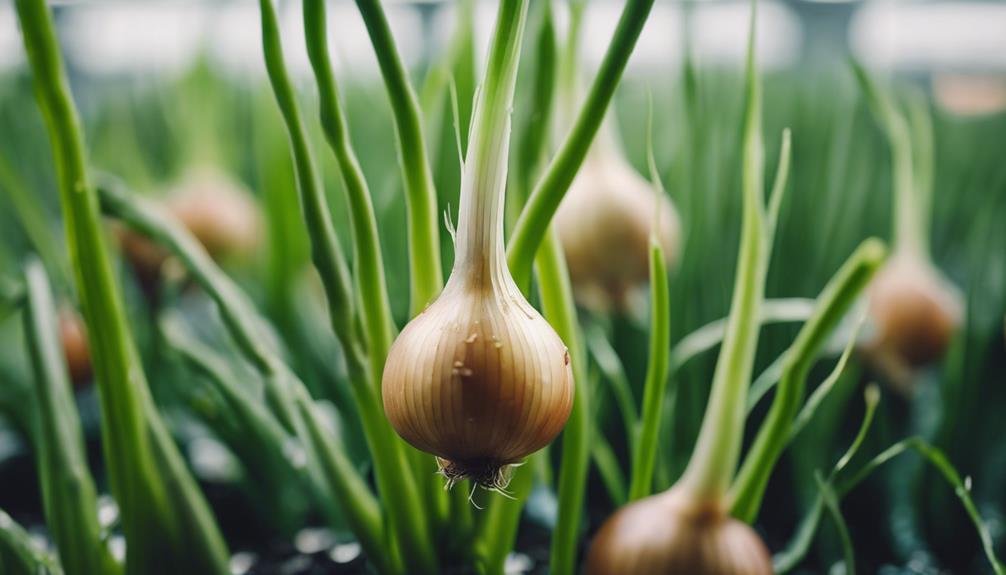
When maintaining the health and longevity of your onion plants in an aquaponics system, it’s crucial to have a solid grasp of effective pest and disease management. Here are some key points to consider when dealing with onion pests and diseases:
- Identifying Common Pests: Keep a close watch for onion thrips, onion maggots, and onion root maggots as they can cause substantial harm to your onion plants.
- Monitoring for Common Diseases: Stay vigilant for bacterial soft rot, downy mildew, and pink root disease, as these diseases can spread rapidly and damage your onion crop.
- Utilizing Integrated Pest Management: Implement strategies such as crop rotation and introducing beneficial insects to naturally control pests and maintain a healthy environment for growing onions.
Enhancing Onion Flavor in Aquaponics
To enhance the flavor of onions in aquaponics, it’s crucial to carefully monitor and adjust key nutrient levels in the system. Specifically, nutrients like nitrogen, zinc, and potassium play a vital role in improving the taste of onions. Nitrogen is essential for vibrant leaf color and enhanced flavor, while zinc contributes significantly to growth and flavor, and potassium ensures healthy growth and flavorful onions.
Maintaining a neutral water pH is also important as it can enhance the flavor of onions. It’s recommended to monitor nitrogen levels and make adjustments when the onion leaves transition from deep green to medium green to further enhance the taste. Keeping an eye on zinc levels is also necessary for optimal growth and flavor development. By effectively managing these key nutrients, you can elevate the flavor of your aquaponic onions, resulting in delicious salads that stand out.
In addition to nutrient management, using high-quality seeds or seedlings specifically bred for flavor can also make a difference in enhancing the onion taste in aquaponics. Varieties such as Candy Hybrid and Red Baron are known for their exceptional flavor profiles and can be a great choice for growing flavorful onions in your aquaponic system. By combining proper nutrient management with the right seed selection, you can ensure that your aquaponic onions aren’t only tasty but also of high quality.
Troubleshooting Common Onion Issues

When dealing with common onion issues in your aquaponics system, it’s essential to troubleshoot problems such as yellowing leaves, stunted growth, bulb splitting, bolting, and pest infestations effectively.
If you notice yellowing leaves, it could indicate a nitrogen deficiency. To address this, you can adjust the fish feed or add supplemental nutrients to ensure healthy onion growth.
Stunted growth is another issue to watch out for, which may be caused by low zinc levels. Keep a close eye on zinc levels and supplement when necessary to prevent stunted growth and small bulbs.
To prevent bulb splitting, maintain stable water conditions. Inconsistent watering and nutrient imbalances can lead to bulb splitting, so it’s crucial to ensure a consistent environment for your onions to thrive.
Frequently Asked Questions
Can Onions Be Grown in Aquaponics?
Onions can thrive in aquaponics systems with the right conditions. These plants benefit from the nutrient-rich water found in aquaponics setups. They prefer consistent temperatures and do well in gravel beds that provide good drainage. By ensuring that your aquaponics system meets these requirements, you can successfully grow onions in this environment. This can lead to a bountiful harvest of fresh, flavorful onions for your culinary needs. Consider varieties like Red Baron, Texas Early Grano, or Sweet Spanish for a diverse onion harvest. With proper care and attention, you can enjoy a steady supply of homegrown onions from your aquaponics system.
How Long Does It Take to Grow Lettuce in Aquaponics?
In aquaponics, lettuce usually takes 3-4 weeks to mature, with leaf varieties growing faster than head types. The growth process can be influenced by warmer temperatures, which can speed up the growth rate. It’s important to maintain consistent nutrient levels and pH levels in the water to ensure the health and growth of the lettuce plants. To promote continuous growth, it is recommended to harvest the outer leaves regularly. This practice not only allows for a continuous supply of fresh lettuce but also encourages new leaves to grow. By following these guidelines, you can enjoy a steady harvest of delicious and nutritious lettuce from your aquaponics system.
Why Aquaponics Fail?
Aquaponics fail when there are not enough nutrients, water temperatures fluctuate, pH levels are not well-controlled, or the design of the grow beds is inadequate. It’s crucial to carefully choose fish species and ensure the ideal conditions for success. By mastering these key factors, you can prevent aquaponic failures and cultivate thriving plants in your system. Remember, creating a balanced environment is essential for the overall health and productivity of your aquaponic setup. Consider using quality products like API Master Test Kits to monitor water parameters accurately and make adjustments as needed. Additionally, investing in high-quality fish food like TetraPond Koi Vibrance provides essential nutrients for your aquatic friends, contributing to a successful aquaponic ecosystem.
What Nutrients Are Needed for Lettuce in Aquaponics?
In aquaponics, lettuce requires key nutrients like nitrogen for promoting leafy growth, potassium for regulating water intake, and calcium for maintaining cell structure. It is crucial to monitor and maintain these nutrient levels to support the healthy development of lettuce plants. By ensuring a balanced nutrient supply, you can help your lettuce thrive and flourish in the aquaponics system.
Conclusion
Congratulations on successfully cultivating onions in your aquaponics system! Your dedication to maintaining optimal water quality, temperature, and nutrient levels has paid off, resulting in a plentiful harvest of flavorful onions. By fine-tuning these key factors, you have unlocked the potential for a continuous supply of fresh produce right at your fingertips.
Continuing to explore different onion varieties and growing conditions won’t only diversify your harvest but also enhance the taste profiles of your onions. Consider experimenting with red onions for a vibrant addition to your salads or sweet onions for a milder flavor in your culinary creations.
It’s essential to remember that each onion variety may have specific requirements, so staying attentive to their individual needs will ensure a successful growing season. Keep up the great work, and enjoy the fruits (or rather, onions) of your labor as you savor the satisfaction of growing your own produce in a sustainable and rewarding way. Happy harvesting!